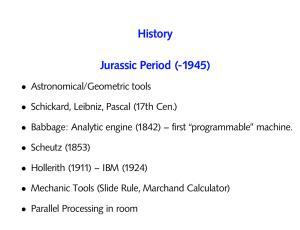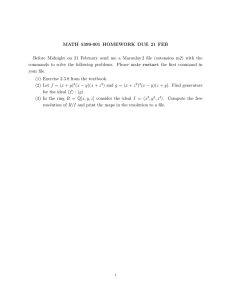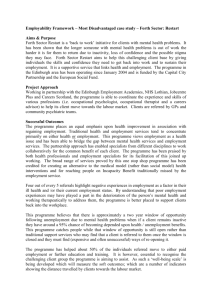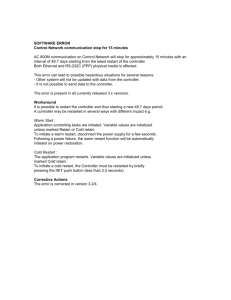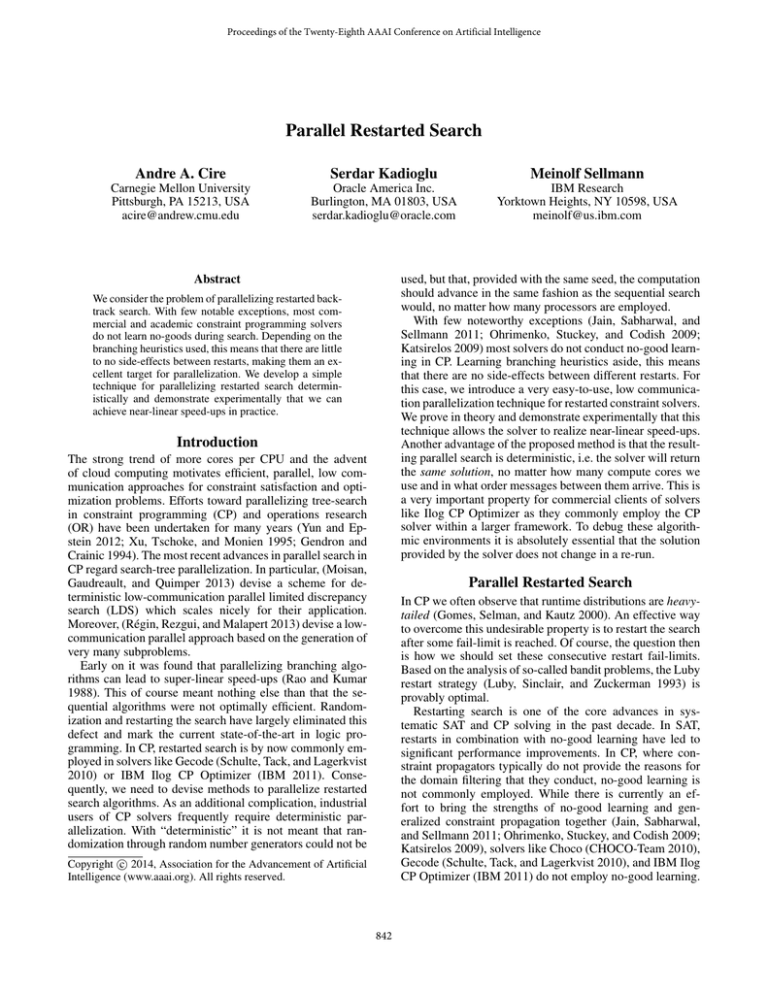
Proceedings of the Twenty-Eighth AAAI Conference on Artificial Intelligence
Parallel Restarted Search
Andre A. Cire
Serdar Kadioglu
Meinolf Sellmann
Carnegie Mellon University
Pittsburgh, PA 15213, USA
acire@andrew.cmu.edu
Oracle America Inc.
Burlington, MA 01803, USA
serdar.kadioglu@oracle.com
IBM Research
Yorktown Heights, NY 10598, USA
meinolf@us.ibm.com
Abstract
used, but that, provided with the same seed, the computation
should advance in the same fashion as the sequential search
would, no matter how many processors are employed.
With few noteworthy exceptions (Jain, Sabharwal, and
Sellmann 2011; Ohrimenko, Stuckey, and Codish 2009;
Katsirelos 2009) most solvers do not conduct no-good learning in CP. Learning branching heuristics aside, this means
that there are no side-effects between different restarts. For
this case, we introduce a very easy-to-use, low communication parallelization technique for restarted constraint solvers.
We prove in theory and demonstrate experimentally that this
technique allows the solver to realize near-linear speed-ups.
Another advantage of the proposed method is that the resulting parallel search is deterministic, i.e. the solver will return
the same solution, no matter how many compute cores we
use and in what order messages between them arrive. This is
a very important property for commercial clients of solvers
like Ilog CP Optimizer as they commonly employ the CP
solver within a larger framework. To debug these algorithmic environments it is absolutely essential that the solution
provided by the solver does not change in a re-run.
We consider the problem of parallelizing restarted backtrack search. With few notable exceptions, most commercial and academic constraint programming solvers
do not learn no-goods during search. Depending on the
branching heuristics used, this means that there are little
to no side-effects between restarts, making them an excellent target for parallelization. We develop a simple
technique for parallelizing restarted search deterministically and demonstrate experimentally that we can
achieve near-linear speed-ups in practice.
Introduction
The strong trend of more cores per CPU and the advent
of cloud computing motivates efficient, parallel, low communication approaches for constraint satisfaction and optimization problems. Efforts toward parallelizing tree-search
in constraint programming (CP) and operations research
(OR) have been undertaken for many years (Yun and Epstein 2012; Xu, Tschoke, and Monien 1995; Gendron and
Crainic 1994). The most recent advances in parallel search in
CP regard search-tree parallelization. In particular, (Moisan,
Gaudreault, and Quimper 2013) devise a scheme for deterministic low-communication parallel limited discrepancy
search (LDS) which scales nicely for their application.
Moreover, (Régin, Rezgui, and Malapert 2013) devise a lowcommunication parallel approach based on the generation of
very many subproblems.
Early on it was found that parallelizing branching algorithms can lead to super-linear speed-ups (Rao and Kumar
1988). This of course meant nothing else than that the sequential algorithms were not optimally efficient. Randomization and restarting the search have largely eliminated this
defect and mark the current state-of-the-art in logic programming. In CP, restarted search is by now commonly employed in solvers like Gecode (Schulte, Tack, and Lagerkvist
2010) or IBM Ilog CP Optimizer (IBM 2011). Consequently, we need to devise methods to parallelize restarted
search algorithms. As an additional complication, industrial
users of CP solvers frequently require deterministic parallelization. With “deterministic” it is not meant that randomization through random number generators could not be
Parallel Restarted Search
In CP we often observe that runtime distributions are heavytailed (Gomes, Selman, and Kautz 2000). An effective way
to overcome this undesirable property is to restart the search
after some fail-limit is reached. Of course, the question then
is how we should set these consecutive restart fail-limits.
Based on the analysis of so-called bandit problems, the Luby
restart strategy (Luby, Sinclair, and Zuckerman 1993) is
provably optimal.
Restarting search is one of the core advances in systematic SAT and CP solving in the past decade. In SAT,
restarts in combination with no-good learning have led to
significant performance improvements. In CP, where constraint propagators typically do not provide the reasons for
the domain filtering that they conduct, no-good learning is
not commonly employed. While there is currently an effort to bring the strengths of no-good learning and generalized constraint propagation together (Jain, Sabharwal,
and Sellmann 2011; Ohrimenko, Stuckey, and Codish 2009;
Katsirelos 2009), solvers like Choco (CHOCO-Team 2010),
Gecode (Schulte, Tack, and Lagerkvist 2010), and IBM Ilog
CP Optimizer (IBM 2011) do not employ no-good learning.
c 2014, Association for the Advancement of Artificial
Copyright Intelligence (www.aaai.org). All rights reserved.
842
One advantage of not performing no-good learning is that
the different restarts offer potential for parallelization. Note
that standard tree-search parallelization is somewhat problematic for searches that have fail-limits. This is particularly
true when the parallelization is required to be deterministic,
which is frequently the case for debugging purposes and industrial users as outlined above. To replicate the sequential
behavior we would need to collect the exact same failures
that a sequential run encounters. Since we cannot know apriori where these failures will occur we either run the risk
of searching a superfluous part of the search tree, or we need
to parallelize work close to the leaf level of the search tree –
which results in a high communication overhead from sharing small sub-problems, especially in a highly distributed
hardware environment.
P1
P2
1
2
P3
P4
3
4
P1
1
P2
2
P3
P4
5
6
3
4
P1
1
P2
2
P3
7
P4
5
3
4
8
10
6
11
9 12
7
15
13
14
16
Figure 1: Parallel Luby Schedules Considered by Core 4 in a
4 Core Machine. Widths correspond to the length of a restart.
Numbers give the index of the restart in the sequential Luby
sequence.
which neither (Luby and Ertel 1994) nor (Shylo, Middelkoop, and Pardalos 2011) provide.
The Luby strategy works as follows. We start with fail
limit {1}. Now we repeat the following until a solution is
found: 1. Repeat all fail-limits considered so far. 2. Run a
restart with double the fail-limit considered last. This results
in a sequence like this: {1}. Repeat all so far: {1}. Double
the last fail-limit: {2}. Repeat all so far: {1, 1, 2}. Double the
last: {4}. Repeat all: {1, 1, 2, 1, 1, 2, 4}. Double: {8}. Since
it does not affect the proof of optimality, in practice we may
multiply each of these Luby fail-limits with some constant
a ∈ IN (typical values are a = 32 or a = 100).
For the purpose of parallelizing restarts, the Luby strategy
is very attractive. Consider the situation when using, for example, geometric restarts: The majority of the time is spent
within the last restart. If the geometric factor is 2, up to 50%
of the total time is spent in the last restart. Without parallelizing this final search, the most we can ever hope for is
a speed-up of two, no matter how many processors we employ. The Luby strategy does not suffer from this drawback.
To parallelize Luby, we propose the following. Each parallel search process has its own local copy of a scheduling
class which assigns restarts and their respective fail-limits
to processors. This scheduling class computes the next Luby
restart fail-limit and adds it to the processor that has the lowest number of accumulated fails so far, following an earlieststart-time-first strategy. Like this, the schedule is filled and
each process can infer which is the next fail-limit that it
needs to run based on the processor it is running on – without
communication. Overhead is negligible in practice since the
scheduling itself runs extremely fast compared to CP search,
and communication is limited to informing the other processes when a solution has been found.
In Figure 1 we show three parallel Luby schedules that the
process on processor 4 would consider. To get its first faillimit (see leftmost schedule) it would fill the schedule by assigning consecutive Luby fail-limits to processors. Assuming ties are broken by smaller processor number, we would
assign fail-limit {1} to processor 1, {1} to processor 2, and
{2} to processor 3, and again {1} to processor 4. To get its
second fail-limit (see middle schedule) the schedule would
again need to be filled until the next fail-limit is assigned
to processor 4. We assign fail-limit {1} to processor 1 and
fail-limit {2} to processor 2. The following fail-limit {4} is
assigned to processor 4 because it has the lowest accumulated fail-limit: 2 fails accumulated for processor 1, 3 fails
for processor 2, 2 fails for processor 3, and only 1 fail so
Parallel Luby
We can avoid all this by executing the restarts, as a whole, in
parallel. Note that this is different from a strategy that some
parallel SAT solvers follow like, e.g., ManySAT (Hamadi,
Jabbour, and Lakhdar 2009) which executes different restart
strategies in parallel and achieves about a factor 2 speed-up
on 8 processors.
A recent proposal for parallelizing systematic search in
constraint programming was presented in (Yun and Epstein
2012). As in ManySAT, this method, called SPREAD, runs
a portfolio of different search strategies in the first phase.
After a fixed time-limit, SPREAD enters a master-slave
work-sharing parallelization of restarted search, whereby the
search experience from the portfolio-phase is used to determine the way how the search is partitioned in the splitting
phase. While exact speed-ups over sequential search are not
explicitly mentioned in (Yun and Epstein 2012), from the
scatter plot Mistral-CC vs. SPREAD-D in Fig. 4 we can
glean that the method achieves roughly a factor 10 speedup when using 64 processors, whereby the authors mention
that the speed-ups level off when using more than 64 workers. Note also that neither ManySAT, nor SPREAD, nor the
method from (Régin, Rezgui, and Malapert 2013) achieve
deterministic parallelization. This is notably different from
the method developed by (Moisan, Gaudreault, and Quimper
2013) who parallelize least discrepancy search and achieve
about 75% efficiency for their application.
Focusing on restarted search methods, we propose to use
the (potentially scaled) Luby restart strategy and execute
it, as a whole, in parallel. Parallel universal restart strategies have been studied in the literature before (see (Luby
and Ertel 1994) and its correction in (Shylo, Middelkoop,
and Pardalos 2011)). In (Shylo, Middelkoop, and Pardalos
2011), non-universal strategies are studied, which are not directly applicable in practice. Moreover, speed-ups over the
best non-universal sequential strategy are inherently sublinear.
We will show: In contrast to optimal non-universal restart
strategies, the universal Luby strategy can be parallelized
with near-perfect efficiency. Furthermore, we can achieve
this with an extremely simple method that requires no sophisticated parallel programming environment such as MPI.
To boot, we can achieve a deterministic parallelization,
843
far for processor 4. The rightmost schedule shows how the
process continues.
Analysis
The question now is obviously how well the simple earlieststart-time-first strategy parallelizes our search. Let us study
the speed-up that we may expect by this method.
Proof. The core to the proof is the realization that, before
the Luby strategy considers the first restart of length 2k , it
incurs at least k2k failures (not restarts!). For example, before the first restart with fail-limit 4 = 22 Luby will run
restarts with fail-limits 1, 1, 2, 1, 1, 2. In total, it has encountered 8 = 2 ∗ 22 failures earlier.
To assess the speed-up of our parallelization method we
will need to bound from above the ratio of the total elapsed
parallel time over the total sequential time. Note that this ratio will only grow when the sequential runtime is lower and
the parallel time stays the same. Consequently, w.l.o.g. we
can assume that the successful restart is the one that determines the parallel makespan. To give an example, consider
the rightmost schedule in Figure 1. Assume the successful
restart is the 16th. By assuming that we already get a solution at the very end of Restart 15 we have lowered the sequential runtime, but the parallel runtime (the width of the
schedule) remains the same.
Now, consider the situation when the last restart was
scheduled. By the earliest-start-time rule, we know that all
processors are working in parallel on earlier restarts up to
the elapsed time when the last restart begins. If we consider
again the right-most schedule in Figure 1, note that processors 1 through 4 are all busy with restarts 1 to 14 from the
start to the begin of Restart 15.
Let TB be the total number of failures before the final
restart, and let TS be the failures allowed in the final, successful restart. Finally, assume that 2k is the longest restart
we encounter sequentially before we find a solution. Note
this implies TS ≤ 2k .
By our observations above, we know that the work on TB
is perfectly parallelized. Consequently, the parallel time is
at most TpB + TS . Now let us consider the ratio of parallel
2
3
P1
1
P2
2
3
7
6
P1
1
P2
2
3
7
6
10
P3
4
P3
4
8
P3
4
8
11
P4
5
P4
5
9
P4
5
9
12
Assuming that we know the speeds of the compute cores
available to us, we will modify our parallelization method
slightly as follows: Given are p processors, each associated
with a different slow-down factor si ≥ 1 which measures
the slow-down of the processor i compared to the fastest
core available to us which has slow-down factor 1.0. The
estimated time needed to complete 2k failures on core i is
then si 2k . Thus, the time it takes to complete a restart differs depending on the core we assign it to. We take this into
account when building the schedule by assigning the next
fail-limit to a processor such that the total makespan of the
schedule is minimized. That is, when assigning a restart to a
core we multiply by that core’s slow-down factor and follow
an earliest-completion-time-first strategy.
We illustrate the method in Figure 2. We assume the slowdown factor of cores 1 and 2 is 1.0 and 1.5, respectively, and
the slow-down of cores 3 and 4 is 2.0. Our first fail-limit
is {1} which requires time 1 on core 1, time 1.5 on core 2,
and time 2 on either core 3 or 4. By the earliest-completiontime-first rule this fail-limit is assigned to core 1. The second
fail-limit is also {1}. The fastest way to complete this restart
is to assign it to core 2 where it will take time 1.5. The third
fail-limit is {2}. If we assign it to core 1 it will be completed
after 2 additional time units and 3 time units since we began
our computation. If we assign it to core 2 would require 3
time units and would complete after 4.5 time units since the
start of the computation. Finally, if we assigned this restart
to either core 3 or 4 it would require 4 time units and thus
complete later than by assigning it to core 1. Hence, we assign the third restart to core 1. The fourth fail-limit is {1}
and will complete earliest at time 2 when assigned to core 3.
The fifth restart, finally, also has fail-limit {1} and is the first
restart assigned to core 4.
Accordingly we schedule restart 6 with fail-limit {2} on
processor 2, and restarts 7 and 8 with fail-limit {1} on processor 3 and 4, respectively. Figure 2 shows the first three
schedules that core 4 would consider.
+TS
S
elapsed time over sequential time: TpB +TS ≤ p1 + TsT+T
.
B
k
And thus, using our initial observation that TB ≥ k2 ≥
TB
1
P2
Figure 2: Parallel Luby Schedules Considered by Core 4 on
a 4-Core distributed system with different processor speed.
Widths correspond to the time of a restart needed on the respective core. Numbers give the index of the restart in the
Luby sequence.
Theorem 1. The parallel Luby restart schedule achieves
asymptotic linear speed-ups when the number of processors
p is constant and the number of restarts grows to infinity.
TB
P1
+TS
1
. Consequently, as the number of
kTS : TpB +TS ≤ p1 + 1+k
restarts (and hence k) grows, the speed-up approaches p.
Theorem 2. The adjusted parallel Luby restart schedule
achieves asymptotic maximum speed-ups when the number
of processors p is constant and the number of restarts grows
to infinity.
In modern cloud computing we often deal with a heterogeneous pool of compute cores that could be heavily distributed. Thanks to the fact that parallelizing restarts requires communication only upon termination, in our method
we can employ loosely coupled compute clusters that could
even be located on different continents. However, we will
need to take into account differing hardware characteristics
that would lead to different average speeds per failure.
Proof. Going back to the proof of Theorem 1 we make
two observations: First, in a homogeneous cluster where all
processors have the same speed, the earliest-start-time-first
scheduling rule is the same as the earliest-completion-timefirst rule. Second, the key to the proof is really the relation
844
Comparison with Existing Techniques
of the work that is fully parallelized compared to the work
that is not or only imperfectly parallelized.
To assess the latter, we will consider the total work that
could have been performed in parallel to the last successful
restart (which we will again assume, w.l.o.g., determines the
makespan). Due to the earliest-completion-time scheduling
rule we know that, when the successful restart is scheduled
on processor i, each other processors must already be busy
with earlier restarts to a point where they could not conduct
the work required to complete the final restart before processor i is done with it. If we denote with TS the time required
for the final restart on the fastest processor, then the total
work that could be conducted while processor i is working
on the last restart is bounded from above by TS (p − 1).
Denote with Tpar the total elapsed time when using all p
processors, and denote with Tseq the sequential time needed
on the fastestPprocessor with slow-down factor 1. Then,
Tseq ≥ Tpar j s1j − (p − 1)TS . Set again k such that 2k
is the highest fail-limit in any restart before we find a solution. We have, TS ≤ 2k and Tseq ≥ (k + 1)2k . Then, 1 ≥
Tpar P 1
Tpar
(p−1)2k
p−1
P1 1 +
P 1 .
j sj − k+1 and thus Tseq ≤
Tseq
(k+1)
j sj
Typically, parallel CP approaches focus on parallelizing the
tree-search itself, see e.g., (Perron 1999). As said earlier,
this creates problems when using restarted search methods when deterministic parallelization is required. Moreover, parallelizing tree-search requires sophisticated load
balancing schemes. Although simple in concept, parallelizing tree-search is a real challenge and not easy to implement efficiently. (see e.g. (Rolf and Kuchcinski 2010;
Boivin, Gendron, and Pesant 2008; Yun and Epstein 2012)).
In a heterogeneous compute environment with potentially
very high communication costs this task becomes even more
daunting.
(Bordeaux, Hamadi, and Samulowitz 2009) propose a different technique for parallelizing search in CP, namely to
split the search space “evenly” first and then search the different parts in parallel. Experiments on n-queens problems
show very good scaling behavior. The issue with this technique is of course that, in general, an “even” split of the
search space is hardly achievable by any generic technique:
some parts will be proven unsatisfiable more quickly, while
others take a long time to search through. In fact, if we could
guarantee an even split, then we could also count the numbers of solutions effectively — a problem that is known to be
#P-complete, which is believed to be strictly harder than the
original NP-hard problem we were trying to solve. Fittingly,
the results reported in (Bordeaux, Hamadi, and Samulowitz
2009) show a much more modest scaling behavior for realworld SAT problems, where speed-ups of about a factor 8
are achieved with 64 cores (whereby no-good learning additionally complicates things).
j sj
Again, as the number of restarts grows to infinity, k grows
P to
infinity, and we asymptotically achieve a speed-up of j s1j ,
which is the maximum we can hope for for the given compute power.
Deterministic Parallel Execution
Finally, let us consider the problem of executing the parallel
schedule deterministically. As discussed earlier, in industrial
practice we often need to ensure that the solutions provided
by the program are identical, no matter how many processors
are assigned to solve the problem or in what order messages
between processes arrive. In Figure 1, on top of the actual
fail-limit expressed by the width of the blocks, we denote the
index of each restart in the Luby sequence. For the scheduler
it is obviously easy to keep track of this index, since it fills
the schedule consecutively anyway.
Now let us assume that we have access to as many deterministic random number generators as restarts needed to
solve the problem. While this is not perfect in theory, in
practice we could, for example, use the same deterministic
random number generator with a different deterministically
randomized seed for each restart. Then, we can deterministically assign each restart its own random number generator –
and thus make the parallel execution deterministic, no matter how many processors are used. The only caveat is that
a restart that follows later in the Luby sequence may find
a solution before the first successful restart in the sequence
(note that the latter may have a larger fail-limit!). To ensure
that the first solution is returned that would be found if the
restarts were executed in sequential order, all we need to do
is to complete restarts with lower indices even when a restart
with higher index reports that a solution had been found.
Note that this additional work does not affect our proofs of
Theorems 1 and 2, so we can still expect near-linear speedups in practice.
(Régin, Rezgui, and Malapert 2013) attack this problem
by generating very many subproblems and then handing
them to workers dynamically as these become idle. Experiments show that this leads to reasonable load-balancing, that
is slightly outperforming work-stealing, at very low communication costs. However, no determinism is achieved this
way, nor is the basis of parallelization a restarted algorithm
which is the state-of-the-art in sequential CP. (Moisan, Gaudreault, and Quimper 2013)’s scheme for parallelizing LDS
also enjoys very low communication costs and is furthermore deterministic under the same no-side-effects assumption we make. For cases where LDS works this is a great
technique, with reported speed-ups around 75% on a special
application. On the downside, we know that LDS can exhibit
the same heavy-tailed runtime distributions that randomizations and restarts overcome.
In summary, parallelizing restarts offers an easy-toimplement alternative that can provide deterministic solutions based on the state-of-the-art sequential algorithm.
However, we need to be sure that there are no side-effects
between restarts as they would be caused by no-good learning or learning branching methods. In the following experimental section we will therefore analyze the real speed-ups
achieved in practice.
845
QCP
Magic Square
Costas Array
30
40
12
13
14
15
16
15
16
17
18
19
Proc.
% Solved
76
86
100
100
54
8
2
100
100
100
44
8
20
0
1
#Cpoints
32.3M
8.1M
4M
23.6M
72.9M
94.5M
83.2M
0.16M
0.64M
7M
28.1M
31.6M
33.7M
avg. Time
1378
784
58.1
364
1354
1951
1987
6.52
28.9
320
1523
1868
2000
Proc.
% Solved
82
100
100
100
82
26
4
100
100
100
68
10
2
2
#Cpoints
49.8M
9.4M
4.1M
23.8M
111M
185M
175M
0.16M
0.64M
7M
46.6M
68.1M
63.8M
avg. Time
940
338
27.1
176
944
1807
1961
2.93
12.4
151
1132
1849
1989
Proc.
% Solved
86
100
100
100
98
34
4
100
100
100
92
24
2
4
#Cpoints
64M
9.6M
4.1M
24.1M
139M
332M
318M
0.17M
0.67M
7.1M
57.5M
112M
115M
avg. Time
749
165
12.8
86.1
566
1590
1942
1.56
6.94
87.5
799
1761
1977
% Solved
90
100
100
100
100
60
12
100
100
100
94
50
6
Proc.
8
#Cpoints
96.6M
9.9M
4.2M
24.3M
143M
504M
614M
0.18M
0.69M
7.2M
69.3M
185M
209M
avg. Time
555
76.4
6.8
44.6
313
1314
1876
0.79
3.12
40.8
482
1522
1959
Proc.
% Solved
98
100
100
100
100
82
16
100
100
100
98
78
14
16
#Cpoints
146M
9.8M
4.2M
24.1M
141M
714M
1170M
0.19M
0.77M
7.3M
72.6M
265M
374M
1879
avg. Time
310
27.83
3.75
24.7
159
930
1813
0.54
2.20
22
298
1150
Proc.
% Solved
98
100
100
100
100
94
30
100
100
100
100
95
16
32
#Cpoints
167M
9.9M
4.2M
24.1M
141M
881M
2091M
0.05M
0.24M
1.4M
7.9M
73.2M
27.0M
avg. Time
208
17.66
2.21
12.9
81.6
595
1677
0.38
1.36
11.9
138
694
1783
Table 1: Performance on Quasigroup Completion, Magic Square and Costas Array Problems of increasing size utilizing between
1 and 16 processors. The time limit was set to 2,000 seconds.
Experimental Results
We next considered Magic Squares and for each order
used 50 random seeds. We see that magic square problems
of smaller orders are indeed easy to solve. For order 12 and
13, we find that 2,000 seconds are enough to solve the instance with just one processor, for all 50 random seeds. This
gives a clear idea how well our technique scales when we
can assess speed-ups between runs that solve all instances.
For example for order 13, the runtime drops from 364 sequential seconds to 12.9 seconds on 32 cores, which is 88%
efficient. For higher orders, we need more processors, e.g.,
for order 14, 8 processors are needed to solve all instances.
From here on we observe almost linear speed-ups: The average elapsed time using 8 processors is 313 seconds, and for
32 processors, the time is down to 81.6 seconds – almost exactly 4-times faster than the average time with 8 processors.
The results for the Costas arrays confirm the observations
made on magic squares problem. Again, speed-ups almost
perfectly linear: Solving order 17 takes 320 sequential seconds, 151 on two, 87.5 on four, 40.8 on eight, 22 on 16, and
11.9 seconds on 32 processors.
Our last experiment was performed on the instances from
the Minizinc Challenge using Gecode solver. This solver
uses a search strategy based on active failure count with a
decay of 0.99 and geometric restarts (scale factor 1,000 and
base 2), and implements a tree-search parallelization technique. We compare GE code’s default parallelization with
our parallel Luby restart strategy (PLR). We use a static failure count reset at the beginning of each restart. To randomize
the restarts, again, the first five branching variables are selected uniformly at random. Notice that the default Gecode
We first evaluated our proposed approach on 3 distinct
problem domains: Quasi-Group Completion (QCP), Magic
Squares, and Costas Arrays (Costas 1984). All experiments
were conducted on Intel Xeon 2.4 GHz computers with varying number of cores as required by each run. We employed
Gecode solver with 2,000 second timeout and all experiments presented use a Luby scaling factor of 64.
The results of our first experiments are summarized in Table 1. We present the percent of solved instances, number
of choice points, and average time for problem type under
varying number of processors. These experiments followed
minimum domain variable ordering with random tie breaking and minimum value heuristic, except that the first five
variables are selected uniformly at random.
For QCP, we generated two sets of 50 instances of orders 30 and 40 with 288 and 960 holes respectively. We observe that instances in the first set are harder to solve. Furthermore, the number of solved instances increases when
we have more processors available. At the same time, the
average elapsed time decreases. We cannot assess whether
speed-ups are linear however, since instances that were not
solved with fewer processors contribute a mere 2,000 seconds to the average, even though their actual solving times
would be higher. With 16 and 32 processors, we can almost
solve all of the instances. When we consider the instances
of order 40, we observe that we can solve them all starting from 2 processors. The average elapsed time on these
instances drops from 338 seconds on 2 processors to 17.66
seconds on 32 processors, which is slightly super-linear.
846
1 Proc.
2 Proc.
4 Proc.
8 Proc.
16 Proc.
32 Proc.
Gecode
Solved
Solved
Speed-up
Solved
Speed-up
Solved
Speed-up
Solved
Speed-up
Solved
Speed-up
Default
9
9
3.71
9
1.19
9
2.5
9
1.55
8
2.27
PLR
10
10
2.59
10
3.86
10
12.5
11
13.2
11
35.7
PLR+L
9
8
1.42
9
3.14
10
5.45
11
15.4
11
11.2
Table 2: Performance on instances from Minizinc 2012 Challenge utilizing between 1 and 32 processors. The time limit was
set to 2,000 seconds.
References
solver learns failure counts of variables for branching, i.e., it
carries information between restarts, while PLR resets these
values at the beginning of each restart and thus does not have
any side-effects. We also considered a variant of our technique that allows learning between trials that are performed
on the same processor1 , denoted by PLR+L.
Boivin, S.; Gendron, B.; and Pesant, G. 2008. A load
balancing procedure for. parallel constraint programming.
CIRRELT-2008-32.
Bordeaux, L.; Hamadi, Y.; and Samulowitz, H. 2009. Experiments with massively parallel constraint solving. IJCAI.
CHOCO-Team. 2010. choco: an open source java constraint
programming library. Research report 10-02-INFO, Ecole
des Mines de Nantes.
Costas, J. 1984. A study of a class of detection waveforms having nearly ideal range–doppler ambiguity properties. Proceedings of the IEEE 72(8):996–1009.
Gendron, B., and Crainic, T. 1994. Parallel branch-andbound algorithms: Survey and synthesis. Operations Research 42:1042–2066.
Gomes, C.; Selman, B.; and Kautz, H. 2000. Heavy-tailed
phenomena in satisfiability and constraint satisfaction problems. Journal of Automated Reasoning 67–100.
Hamadi, Y.; Jabbour, S.; and Lakhdar, S. 2009. Manysat: a
parallel sat solver. Journal on Satisfiability, Boolean Modeling and Computation 6:245–262.
IBM. 2011. IBM ILOG CPLEX Optimization Studio 12.2.
Jain, S.; Sabharwal, A.; and Sellmann, M. 2011. A general nogood-learning framework for pseudo-boolean multivalued sat. AAAI.
Katsirelos, G. 2009. Nogood Processing in CSPs. Ph.D.
Dissertation, University of Toronto.
Luby, M., and Ertel, W. 1994. Optimal parallelization of las
vegas algorithms. In Proceedings of the 11th Annual Symposium on Theoretical Aspects of Computer Science, STACS
’94, 463–474.
Luby, M.; Sinclair, A.; and Zuckerman, D. 1993. Optimal
speedup of las vegas algorithms. Information Processing
Letters 47:173–180.
Moisan, T.; Gaudreault, J.; and Quimper, C.-G. 2013. Parallel discrepancy-based search. In Schulte (2013), 30–46.
Ohrimenko, O.; Stuckey, P.; and Codish, M. 2009. Propagation via lazy clause generation. Constraints 14:357–391.
Perron, L. 1999. Search procedures and parallelism in constraint programming. CP 346–360.
Rao, V., and Kumar, V. 1988. Superlinear speedup in parallel
state-space search. Foundations of Software Technology and
Theoretical Computer Science 161–174.
Table 2 presents our results averaged over 11 instances
from the Minizinc 2012 Challenge that can be solved with at
least one of the approaches within 2,000 seconds. These instances are from sb, non-fast, non-awful and amaze2 classes.
Since the default Gecode solver is not deterministic in parallel mode, we report the median values from five runs.
The sequential Gecode solver solved 9 of these instances
within the time limit. When 2 processors are employed, the
run time improves super-linearly as we can see by the average super-linear speed-up of 3.71 on 2 cores. Surprisingly,
using more cores then decays the default performance.
Parallel Luby restarts allows the solver to realize nearlinear speed-ups when more processors are utilized. There
is a visible improvement as we scale the parallelization. Curiously, PLR+L does not perform better and actually decays the performance for large numbers of processors, which
could be a hint why the default’s performance also decays.
In any case, we see that the method presented here scales
very well even for larger numbers of processors for these
challenging benchmarks.
Conclusion
We introduced a simple technique for parallelizing restarted
search in CP that requires almost no communication and is
very easy to implement. Theoretical analysis and experimental results on various CP benchmarks showed that executing
Luby restarts in parallel leads to linear speed-ups in theory
and in practice. Most importantly, the method provides deterministic parallelization.
Acknowledgments
The second author was supported by Paris Kanellakis fellowship at Brown University when conducting the work contained in this document. This document reflects his opinions
only and should not be interpreted, either expressed or implied, as those of his current employer.
1
We thank Christian Schulte for providing us with a version of
Gecode solver that enabled implementation of this strategy.
847
Régin, J.-C.; Rezgui, M.; and Malapert, A. 2013. Embarrassingly parallel search. In Schulte (2013), 596–610.
Rolf, C., and Kuchcinski, K. 2010. Parallel solving in constraint programming. In MCC 2010: Third Swedish Workshop on Multi-Core Computing.
Schulte, C.; Tack, G.; and Lagerkvist, M. Z. 2010. Modeling
and programming with gecode.
Schulte, C., ed. 2013. Principles and Practice of Constraint Programming - 19th International Conference, CP
2013, Uppsala, Sweden, September 16-20, 2013. Proceedings, volume 8124 of Lecture Notes in Computer Science.
Springer.
Shylo, O.; Middelkoop, T.; and Pardalos, P. 2011. Restart
strategies in optimization: parallel and serial cases. Parallel
Computing 37(1):60–68.
Xu, C.; Tschoke, S.; and Monien, B. 1995. Performance
evaluation of load distribution strategies in parallel branch
and bound computations. SPDP 402–405.
Yun, X., and Epstein, S. 2012. A hybrid paradigm for adaptive parallel search. CP 720–734.
848



